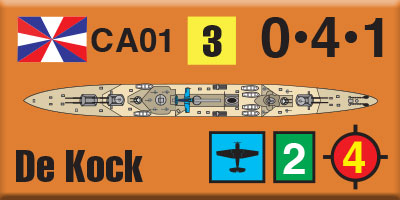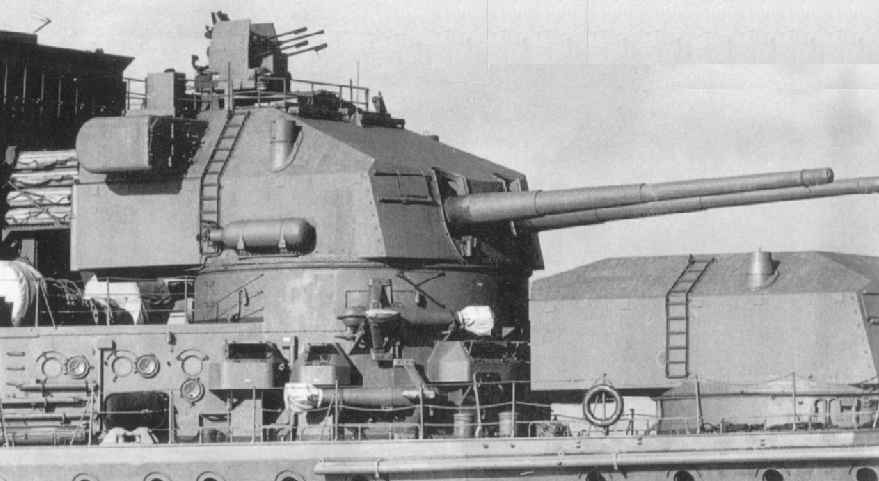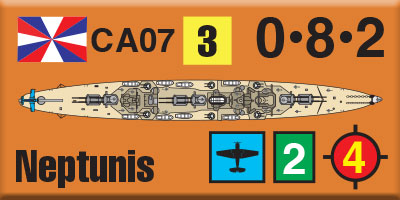| The King’s Ships
Dutch Heavy Cruisers
By Mike Bennighof, Ph.D.
August 2022
 While the new, fast battle cruisers projected for the Royal Netherlands Navy would give its fleet defending the East Indies an edge over the big Japanese “Type A” heavy cruisers, the Dutch admirals also sought heavy cruisers of their own to match the Japanese. While the new, fast battle cruisers projected for the Royal Netherlands Navy would give its fleet defending the East Indies an edge over the big Japanese “Type A” heavy cruisers, the Dutch admirals also sought heavy cruisers of their own to match the Japanese.
The light cruiser De Ruyter had been designed as a small heavy cruiser, but several rounds of cost cutting reduced both size and armament to that of a small light cruiser. She was a great disappointment, and the Dutch admirals wanted some true heavy cruisers to counter the Japanese ships they would surely meet in any future war. That didn’t happen, thanks to economic despair and constant budget cuts. But in the world of the Second Great War, the Great Depression would be a only a middling recession. The Netherlands is a much wealthier country in our alternative history, and is able to afford the weapons to defend its colonial empire.
The first class of heavy cruisers laid down for the Royal Netherlands Navy is based on the original proposal for De Ruyter, with six 203mm (8-inch) guns in three twin turrets. She’s designed to counter the initial classes of Japanese heavy cruisers, each of which carried six 8-inch guns as well. She’s larger than the Furutaka class, with better range and protection, and has better distribution of her armament (the Japanese would rebuild Furutaka and her sister in the 1930’s, and built the similar Aoba class with twin turrets from the start).
The De Kock class cruisers come in at about 9,000 tons’ displacement, and can make 32 knots at top speed. They have the excellent Hazemeyer fire control system shared by other Dutch cruisers, and very good anti-aircraft protection following the standard practice of the Royal Netherlands Navy. They carry six torpedo tubes as well, with surface combat seen as their primary mission.'

Six of the class entered Dutch service between 1925 and 1931; all were modernized in the late 1930’s. In 1941, three of them are in home waters and the other three in the Dutch East Indies. This enlarged De Ruyter was a much more capable fighting ship than the actual De Ruyter, but would not stand up well against the new heavy cruisers building in Europe and the United States. The Dutch had excellent naval intelligence, both in this world and our alternative history, and soon discovered that their own new cruisers would be out-classed by the next classes of Japanese ships. They were going to need a bigger ship.
During the 1920s in our reality, Dutch firms fronted for the Germans in a number of areas of weapons development, including warship design. That in turn yielded contacts in Germany once open re-armament commenced, and so plans for the Hipper class heavy cruisers came into Dutch hands. The admirals wanted a similar ship for the East Indies, thinking the design — if modified to Dutch standards — a good counter to the big Japanese heavy cruisers.
With intelligence reports showing that the new Japanese Type A cruisers would carry ten 8-inch guns in five twin turrets, the new Dutch ship would go one better, with a dozen guns in six twin turrets. She would need to be individually superior to the Japanese Myoko class and the similar ships that followed, and since the Netherlands had never been asked to sign the naval limitations treaties, she could be much larger than the claimed displacement of the Japanese ships (and even slightly larger than their actual dimensions).

Bow turrets of the Neptunis-class cruiser Vergulde Haan.
The Dutch Neptunis class displaces 17,000 tons, compared to 10,000 tons (stated) or 15,000 tons (actual) displacement of the big Japanese cruisers. Neptunis, laid down in 1935, is an enlarged version of the Hipper design (another variant, with triple turrets in place of twins, appears in The Cruel Sea serving the Imperial German Navy). The Hipper design was a very large ship, with a comparatively light armament (eight 203mm guns) for its size; like the High Seas Fleet, the Dutch have also corrected this.
Neptunis carries three pairs of twin turrets for her main armament: two forward, two aft and two amidships. Her engine rooms are forward of the amidships barbettes, and the turbines between them and the after turrets, with turbo-electric drive allowing the separation and greater protection. Maximum speed is 32 knots, considered sufficient for fleet actions but acknowledged as substantially less than the nearly-unarmored Myoko.
Unlike her German cousins, Neptunis carries 203mm guns, a Dutch version of the German C34 rifles that armed the Hipper class (the Imperial German variant carries 210mm guns – the Central Powers all cheat on the agreed armament and displacement limits). The Dutch, unlike the Germans, have a very good dual-purpose secondary weapon and have armed Neptunis with the same anti-aircraft suite as the larger battle cruisers: a dozen very effective 120mm (4.7-inch) dual-purpose weapons in six dual mounts, plus a dozen more 40mm automatic weapons.

She’s also much better protected than her Japanese rivals, but her armor is only proof against 8-inch shellfire; she’s the size of a small battleship, but not capable of standing up against an actual battleship or battle cruiser. Like the previous class, she carries six torpedo tubes and is intended for surface combat.
The Royal Netherlands Navy laid down two of them per year starting in 1935; when the Netherlands enters the Second Great War in September 1941, a year after the fighting begins, there are six of them in service. Four are stationed in the Dutch East Indies, and two in European waters, with two more fitting out and almost ready for service. It would be Neptunis herself that fired the shots that brought the Netherlands into the Second Great War.
The degree of fantasy involved in the various ships included in the Second Great War differs from design to design of course, but these big cruisers were exactly what the Royal Netherlands Navy wanted for the East Indies station. They were well within Dutch financial and industrial capability to build, even if some economically conservative politicians preferred to cling to balanced budgets and the gold standard rather than face up to the threat presented by Axis aggression. In The Second Great War setting, it’s British and Japanese pressure, with the Dutch ready to meet this test.
All of the new battle cruisers and the big heavy cruisers appearing in our massive alternative-history expansion set The King’s Ships bear the names of famous Dutch warships of the Golden Age, accounting for some of those that seem less-than-warlike. Ever-conscious of each gulden in 1639 just like 1939, the Dutch relied heavily on conscripted merchant ships in their battle fleets and these retained their names in naval service.
Click here to join the Gold Club.
See your Gold Club Insider newsletter for ordering information.
Sign up for our newsletter right here. Your info will never be sold or transferred; we'll just use it to update you on new games and new offers.
Mike Bennighof is president of Avalanche Press and holds a doctorate in history from Emory University. A Fulbright Scholar and NASA Journalist in Space finalist, he has published a great many books, games and articles on historical subjects; people are saying that some of them are actually good.
He lives in Birmingham, Alabama with his wife and three children. He misses his Iron Dog, Leopold.
Want to keep Daily Content free of third-party ads? You can send us some love (and cash) through this link right here.
|
